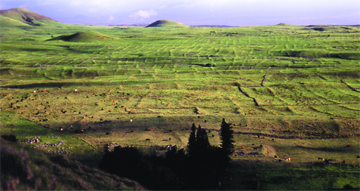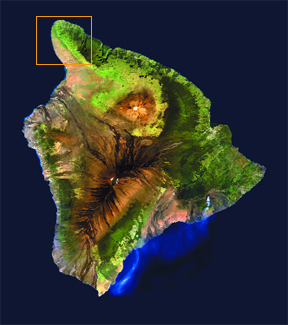
 Polynesians
settled the Hawaiian islands around A.D. 800 and within a few hundred years,
developed highly complex societies and agricultural systems. Sweet potato was
the staple on the geologically younger islands of Maui and the Big Island, while
irrigated taro was the staple on the older islands of Kauai, Molokai and Oahu.
Although researchers have fleshed out the basics of this agricultural history,
they have not been able to figure out why the crops were only cultivated in
the select areas. Scientists now say that the answer may be in the diversity
of the soils, which may have even led to the rise of powerful chiefdoms on the
islands beginning in the 16th century.
Polynesians
settled the Hawaiian islands around A.D. 800 and within a few hundred years,
developed highly complex societies and agricultural systems. Sweet potato was
the staple on the geologically younger islands of Maui and the Big Island, while
irrigated taro was the staple on the older islands of Kauai, Molokai and Oahu.
Although researchers have fleshed out the basics of this agricultural history,
they have not been able to figure out why the crops were only cultivated in
the select areas. Scientists now say that the answer may be in the diversity
of the soils, which may have even led to the rise of powerful chiefdoms on the
islands beginning in the 16th century. Ancient Hawaiians developed complex agricultural systems on stripe-like swaths of land (far right) where the temperature, rainfall and nutrient load conspired to create “sweet spots” in which certain crops could flourish, such as Kohala on the Big Island, pictured here (and in the box on the satellite image at right). Researchers now say that when the population outgrew the surplus produced from these fields, aggressive chiefdoms conquered island communities. Images courtesy Terry Hunt and NASA, respectively.
According to Patrick Kirch, an archaeologist at the University of California, Berkeley, and co-authors in the June 11 Science, small swaths of nutrient-rich soils on the islands provided distinct “sweet spots” for sweet potato and taro. What is remarkable, the team reports, is that the ancient Hawaiians figured this out and exploited it.
Taro crops need a greater amount of water than sweet potatoes, and sweet potatoes are harder to grow above certain elevations. Thus, the researchers expected differences in the crops’ locale to relate to rainfall and temperature, which are both a function of elevation in Hawaii, Kirch says. But that did not tell the whole story, he says, because some areas that should have been good climatically for the crops were not developed. So Kirch, who has been studying Polynesian archaeology for 30 years, and his colleagues turned to the soils. To their surprise, they found a significant difference in the geochemistry of the soils between islands and also between stripe-like swaths on each island.
Two of the sites the researchers studied are Kohala on the Big Island and Kahikinui on Maui, both of which supported large populations and large sweet potato fields but little taro. The sites are on the leeward, drier sides of younger volcanoes and sport rocky soils. Team members Peter Vitousek of Stanford University and Oliver Chadwick of the University of California, Santa Barbara, tested older and younger soils at each site, as well as at varying elevations surrounding the sites, for nutrients, especially phosphorus, and their availability in plants.
The researchers observed varying availability of nutrients at different elevations and in the different soils, Chadwick says. It seems, he says, that the nutrient load, rainfall and temperatures conspired to produce spots where conditions were just right to support large dryland fields of sweet potato. Chadwick found the soils in the cultivated fields to be fairly infertile — although more fertile than the soils outside the sweet spots — but at some point in history these soils had to have been fertile enough to support large-scale agriculture. The researchers needed to test soils of the same age and same elevation that had not been cultivated and depleted from agricultural use. Thus, they dug up virgin soils from beneath rock walls that the ancient Hawaiians had built as windbreaks and trail guides in the cultivated areas. These soils were fairly high in nutrient content.
It makes sense that these sweet spots would be there, as soil formation and nutrient load in Hawaii is primarily driven by temperature and rain, says Ken Rubin, a geochemist at the University of Hawaii. Indeed, anything lower in elevation than these sweet spots would have been too dry, and anything higher in elevation would have been depleted of nutrients due to heavy rainfall washing it away, says Louis Derry, a geologist at Cornell University in Ithaca, N.Y. But what is most fascinating, Rubin and Derry say, is how the ancient Hawaiians worked the system — the cultural component of the science.
On the older islands, ancient Hawaiians primarily grew taro in irrigated pondfields, which were less labor-intensive and produced more surplus than dryland farming on Maui and the Big Island. The need for a larger labor force to work the fields on the younger islands led to larger population centers, ruled by chiefs in a highly complex system.
And for hundreds of years, Kirch says, this peaceful system worked. But by the 16th and 17th centuries, the Hawaiians on Maui and the Big Island had reached the geographical limits of the sweet spots, and the fields were likely beginning to show signs of nutrient depletion. Yet archaeological evidence shows that populations were continuing to grow larger. “These factors combined to create a situation of stress, putting pressure on the sociopolitical system,” Kirch says.
In order to provide food for their burgeoning populations, the chiefs turned to aggressive territorial conquest over settlements on Oahu, Kauai and Molokai. Those settlements had not been affected by food shortages because of the surpluses from the pondfields. And so it seems that the soils may have ultimately been responsible for the societal revolutions at the time.
“It’s neat to put ecosystems and anthropology together and look at how geology affected culture,” Kirch says. “There are definitely lessons to be drawn here,” he says, for sustainable development in tropical locations.

